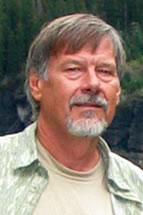Mesozoic and Cenozoic Geologic History and Paleogeography of Southwestern North America

Dr. Ron Blakey
Professor Emeritus, Northern Arizona University
Host: Bonnie Bloeser
Wednesday, May 3 , 2017
CSL 422 – 1 pm
Abstract
The southwestern Cordilleran region was constructed during several distinct tectonic phases over the last 200 million years. Following late Paleozoic terrane accretion, backarc spreading, and the Sonoman orogen, the region was bordered by a west-facing subduction zone with a continental arc to the south and a marine arc farther north. During the Late Triassic and Jurassic, this early Cordilleran subduction zone evolved through several iterations that were marked by complex, poorly understood fringing arcs, ophiolite accretion, and the Nevadan orogen. By the Late Jurassic, the Cordilleran arc/subduction zone stretched from Mexico to Alaska to form an Andean-style margin. The Late Jurassic accretion of Wrangellia generated additional tectonic complications, especially along the northern margin of the region. Farther south in Mexico, the Guerrero terrane accreted in the Early Cretaceous. Following these events, rapid subduction of the Farallon Plate generated voluminous magma along the entire Cordilleran margin. Throughout most of the Cretaceous, the arc complex was marked by a prominent subduction zone – the Franciscan complex, a forearc basin – the Great Valley sequence, and the magmatic arc that included the Sierran, Salinian, Mojave, and Peninsular segments. At ca. 80 Ma, a thickened oceanic slab entered the subduction zone along the margin from the northern Peninsular segment to the southern Sierra segment creating havoc to the entire arc complex; subduction flattened, arc magmatism migrated far eastward into Colorado and New Mexico, and large fragments of the forearc were tectonically eroded or subducted. During the early Cenozoic, normal subduction gradually returned as arc magmatism swung westward across the southern Western Interior leaving behind large volcanic centers.
The final chapter of the geologic evolution began ca. 35 Ma as the East Pacific Rise intercepted the coast at the present latitude of San Diego and expanded both northward and southward to generate a transform margin; as the transform grew, subduction ended along that margin. The Pacific Plate now bordered North America and the rapidly west-moving plate pulled at the North American margin and created a vast zone of extension, normal faulting marked by significant horizontal displacement, and basaltic magmatism. The most complex interaction between the Pacific and North American plates occurred along the northern Peninsular segment where several microplates were transferred from North America to the Pacific Plate. The resulting extension, plate rotation, and northward migration along the Cordillera generated the San Andreas fault system, the Transverse Ranges, and the California Continental Borderlands. Within this complex Miocene to recent setting, a series of mostly deepwater, partitioned basins separated by sharp, narrow uplifts deposited organic-rich sediments.
This complex geologic history can best be portrayed by a series of paleogeographic and paleotectonic maps that clearly show the evolving landscapes and tectonic setting of the southern Cordilleran region.

